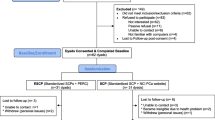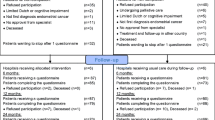Abstract
Purpose
Breast cancer survivorship care plans (SCP) have limited content addressing women’s health issues. This trial tested if young breast cancer survivors who receive a web-based, women’s health SCP were more likely to improve on at least one of the four targeted issues (hot flashes, fertility-related concerns, contraception, and vaginal symptoms) compared to attention controls.
Methods
A randomized controlled trial recruited female survivors ages 18–45 at diagnosis, 18–50 at enrollment, completed primary cancer treatment, and had a significant women’s health issue: moderate or higher fertility-related concerns; ≥ 4 hot flashes/day with ≥ 1 of moderate severity; ≥ 1 moderate vaginal atrophy symptoms; or not contracepting/using less effective methods. Survivors underwent stratified, block randomization with equal allocation to intervention and control groups. The intervention group accessed the online SCP; controls accessed curated resource lists. In intention-to-treat analysis, the primary outcome of improvement in at least one issue by 24 weeks was compared by group.
Results
182 participants (86 intervention, 96 control), mean age 40.0 ± 5.9 and 4.4 ± 3.2 years since diagnosis, were randomized. 61 intervention group participants (70.9%) improved, compared to 55 controls (57.3%) (OR 1.82, 95% CI 0.99–3.4, p = 0.057). The following issue-specific improvements were observed in the intervention versus control arms: fertility-related concerns (27.9% vs. 14.6%, OR 2.3, 95% CI 1.1–4.8); hot flashes (58.5% vs. 55.8%, OR 1.1, 95% CI 0.57–2.2); vaginal symptoms (42.5% vs. 40.7%, OR 1.1, 95% CI 0.6–2.0); contraception (50% vs. 42.6%, OR 1.4, 95% CI 0.74–2.5).
Conclusions
In young breast cancer survivors, a novel, web-based SCP did not result in more change in the primary outcome of improvement in at least one of the four targeted women’s health issues, than the attention control condition. The intervention was associated with improved infertility concerns, supporting efficacy of disseminating accessible, evidence-based women’s health information to this population.



Similar content being viewed by others
References
Su HI, Sammel MD, Green J et al (2010) Antimullerian hormone and inhibin B are hormone measures of ovarian function in late reproductive-aged breast cancer survivors. Cancer 116(3):592–599
Gold EB, Flatt SW, Pierce JP et al (2006) Dietary factors and vasomotor symptoms in breast cancer survivors: the WHEL Study. Menopause 13(3):423–433
Caan BJ, Emond JA, Su HI et al (2012) Effect of postdiagnosis weight change on hot flash status among early-stage breast cancer survivors. J Clin Oncol 30(13):1492–1497
Cvancarova M, Samuelsen SO, Magelssen H et al (2009) Reproduction rates after cancer treatment: experience from the Norwegian radium hospital. J Clin Oncol 27(3):334–343
Safarinejad MR, Shafiei N, Safarinejad S (2013) Quality of life and sexual functioning in young women with early-stage breast cancer 1 year after lumpectomy. Psychooncology 22(6):1242–1248
Cook-Andersen H, Flatt SW, Komrokian S, et al (2011) Breast cancer patients have lower rates of contraception use: a prospective cohort study. In: American society of reproductive medicine annual meeting
Patel A, Schwarz EB (2012) Society of family P. cancer and contraception: release date May 2012. SFP Guideline #20121. Contraception 86(3):191–198
Yoo C, Yun MR, Ahn JH et al (2013) Chemotherapy-induced amenorrhea, menopause-specific quality of life, and endocrine profiles in premenopausal women with breast cancer who received adjuvant anthracycline-based chemotherapy: a prospective cohort study. Cancer Chemother Pharmacol 72(3):565–575
Partridge AH, Gelber S, Peppercorn J et al (2004) Web-based survey of fertility issues in young women with breast cancer. J Clin Oncol 22(20):4174–4183
Gorman JR, Malcarne VL, Roesch SC et al (2010) Depressive symptoms among young breast cancer survivors: the importance of reproductive concerns. Breast Cancer Res Treat 123(2):477–485
Letourneau JM, Ebbel EE, Katz PP et al (2012) Pretreatment fertility counseling and fertility preservation improve quality of life in reproductive age women with cancer. Cancer 118(6):1710–1717
Howard-Anderson J, Ganz PA, Bower JE et al (2012) Quality of life, fertility concerns, and behavioral health outcomes in younger breast cancer survivors: a systematic review. J Natl Cancer Inst 104(5):386–405
Johns C, Seav SM, Dominick SA et al (2016) Informing hot flash treatment decisions for breast cancer survivors: a systematic review of randomized trials comparing active interventions. Breast Cancer Res Treat 156(3):415–426
Seav S, Dominick S, Stepanyuk B et al (2015) Management of sexual dysfunction in breast cancer survivors: a systematic review. Women’s Midlife Health 1:9
Gorman JR, Bailey S, Pierce JP et al (2012) How do you feel about fertility and parenthood? The voices of young female cancer survivors. J Cancer Surviv 6(2):200–209
Bartula I, Sherman KA (2013) Screening for sexual dysfunction in women diagnosed with breast cancer: systematic review and recommendations. Breast Cancer Res Treat 141(2):173–185
Dominick SA, McLean MR, Whitcomb BW et al (2015) Contraceptive practices among female cancer survivors of reproductive age. Obstet Gynecol 126(3):498–507
Io Medicine (2006) Implementing cancer survivorship care planning: workshop summary. National Academy of Sciences, Washington, DC
Gorman JR, Julian AK, Roberts SA et al (2017) Developing a post-treatment survivorship care plan to help breast cancer survivors understand their fertility. Support Care Cancer. https://doi.org/10.1007/s00520-017-3871-9
Tan AS, Moldovan-Johnson M, Gray SW et al (2013) An analysis of the association between cancer-related information seeking and adherence to breast cancer surveillance procedures. Cancer Epidemiol Biomark Prev 22(1):167–174
Nguyen SK, Ingledew PA (2013) Tangled in the breast cancer web: an evaluation of the usage of web-based information resources by breast cancer patients. J Cancer Educ 28(4):662–668
Mayer EL, Gropper AB, Neville BA et al (2012) Breast cancer survivors’ perceptions of survivorship care options. J Clin Oncol 30(2):158–163
Stark SS, Natarajan L, Chingos D et al (2018) Design of a randomized controlled trial on the efficacy of a reproductive health survivorship care plan in young breast cancer survivors. Contemp Clin Trials 77:27–36
Davila GW, Singh A, Karapanagiotou I et al (2003) Are women with urogenital atrophy symptomatic? Am J Obstet Gynecol 188(2):382–388
Sloan JA, Loprinzi CL, Novotny PJ, Barton DL, Lavasseur BI, Windschitl H (2001) Methodologic lessons learned from hot flash studies. J Clin Oncol 19(23):4280–4290
Gorman JR, Malcarne V, Pierce JP et al (2013) A multidimensional scale to measure the reproductive concerns of young adult cancer survivors. J Cancer Surviv 8:218–228
Prevention CfDCa (2010) National survey of family growth. http://www.cdc.gov/nchs/nsfg/nsfg_2006_2010_puf.htm
Gorman JR, Roberts SC, Dominick SA et al (2014) A diversified recruitment approach incorporating social media leads to research participation among young adult-aged female cancer survivors. J Adolesc Young Adult Oncol 3(2):59–65
Logan S, Perz J, Ussher JM et al (2018) Systematic review of fertility-related psychological distress in cancer patients: informing on an improved model of care. Psychooncology. https://doi.org/10.1002/pon.4927
Oktay K, Harvey BE, Partridge AH et al (2018) Fertility preservation in patients with cancer: ASCO clinical practice guideline update. J Clin Oncol 36(19):1994–2001
Fallat ME, Hutter J (2008) Preservation of fertility in pediatric and adolescent patients with cancer. Pediatrics 121(5):e1461–e1469
Network NCC (2019) NCCN Clinical practice guidelines in oncology: adolescent and young adult (AYA) oncology, Version 1.2019, October 3, 2018
Ethics Committee of the American Society for Reproductive Medicine. Electronic address Aao (2018) Fertility preservation and reproduction in patients facing gonadotoxic therapies: an Ethics Committee opinion. Fertil Steril 110(3):380–386
Hadnott TN, Stark SS, Medica ACO et al (2019) Perceived infertility and contraceptive use in the female, reproductive age cancer survivor. Fertil Steril 111:763–771
Anazodo A, Sullivan E, Travaglia J et al (2018) How can we improve oncofertility care for patients? A systematic scoping review of current international practice and models. Hum Reprod Update 25:159–179
Barnett AG, van der Pols JC, Dobson AJ (2005) Regression to the mean: what it is and how to deal with it. Int J Epidemiol 34(1):215–220
Secura GM, Madden T, McNicholas C et al (2014) Provision of no-cost, long-acting contraception and teenage pregnancy. N Engl J Med 371(14):1316–1323
Jacobsen PB, DeRosa AP, Henderson TO et al (2018) Systematic review of the impact of cancer survivorship care plans on health outcomes and health care delivery. J Clin Oncol 36(20):2088–2100
Nicolaije KA, Ezendam NP, Vos MC et al (2015) Impact of an automatically generated cancer survivorship care plan on patient-reported outcomes in routine clinical practice: longitudinal outcomes of a pragmatic. Cluster Randomized Trial. J Clin Oncol 33(31):3550–3559
Maly RC, Liang LJ, Liu Y et al (2017) Randomized controlled trial of survivorship care plans among low-income, predominantly latina breast cancer survivors. J Clin Oncol 35(16):1814–1821
Emery JD, Jefford M, King M et al (2017) ProCare Trial: a phase II randomized controlled trial of shared care for follow-up of men with prostate cancer. BJU Int 119(3):381–389
Boekhout AH, Vincent AD, Dalesio OB et al (2011) Management of hot flashes in patients who have breast cancer with venlafaxine and clonidine: a randomized, double-blind, placebo-controlled trial. J Clin Oncol 29(29):3862–3868
Brothers BM, Easley A, Salani R et al (2013) Do survivorship care plans impact patients’ evaluations of care? A randomized evaluation with gynecologic oncology patients. Gynecol Oncol 129(3):554–558
Hudson MM, Leisenring W, Stratton KK et al (2014) Increasing cardiomyopathy screening in at-risk adult survivors of pediatric malignancies: a randomized controlled trial. J Clin Oncol 32(35):3974–3981
Smith KC, Tolbert E, Hannum SM et al (2016) Comparing web-based provider-initiated and patient-initiated survivorship care planning for cancer patients: a randomized controlled trial. JMIR Cancer 2(2):e12
Fulda KG, Hahn KA, Young RA et al (2011) Recruiting practice-based Research Network (PBRN) physicians to be research participants: lessons learned from the North Texas (NorTex) needs assessment study. J Am Board Fam Med 24(5):610–615
Acknowledgements
This study was conducted in collaboration with Young Survival Coalition, Susan B. Komen Foundation—San Diego, Army of Women.
Funding
This work was supported by the California Breast Cancer Research Program 20OB-0144; National Cancer Institute P30-CA008748.
Author information
Authors and Affiliations
Corresponding author
Ethics declarations
Ethical approval
The clinical trial complies with the current laws of the United States. All procedures performed in studies involving human participants were in accordance with the ethical standards of the institutional and/or national research committee and with the 1964 Helsinki Declaration and its later amendments or comparable ethical standards.
Conflicts of interest
All authors declare that they have no conflict of interest.
Additional information
Publisher's Note
Springer Nature remains neutral with regard to jurisdictional claims in published maps and institutional affiliations.
Electronic supplementary material
Below is the link to the electronic supplementary material.
Rights and permissions
About this article
Cite this article
Irene Su, H., Stark, S., Kwan, B. et al. Efficacy of a web-based women’s health survivorship care plan for young breast cancer survivors: a randomized controlled trial. Breast Cancer Res Treat 176, 579–589 (2019). https://doi.org/10.1007/s10549-019-05260-6
Received:
Accepted:
Published:
Issue Date:
DOI: https://doi.org/10.1007/s10549-019-05260-6




